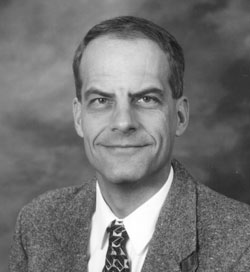2000 Distinguished Lecture Series: Thomas Furtak
It’s Time for a Change to a More Effective Paradigm in College Teaching
Biography
 Tom Furtak received his Ph.D. from Iowa State University in 1975. After a Postdoctoral Fellowship and an appointment as an Associate Physicist with the Ames Laboratory, Tom joined the faculty at Rensselaer Polytechnic Institute as an Associate Professor of Physics. He moved his family west in 1986, assuming his current position as Professor of Physics at the Colorado School of Mines.
Tom Furtak received his Ph.D. from Iowa State University in 1975. After a Postdoctoral Fellowship and an appointment as an Associate Physicist with the Ames Laboratory, Tom joined the faculty at Rensselaer Polytechnic Institute as an Associate Professor of Physics. He moved his family west in 1986, assuming his current position as Professor of Physics at the Colorado School of Mines.
Tom’s research involves the optical characterization of buried interfaces. His early work at helped define the mechanisms of surface enhanced Raman scattering (SERS) and surface optical second harmonic generation (SHG). Other approaches employed by his group include surface EXAFS, waveguide Raman scattering, and spectroscopic ellipsometry. These intrinsically interface-sensitive techniques have been applied to a wide range of problems, including systems under electrochemical control, polymer-polymer boundaries, and thin film materials for devices. The newest capability deals with optical sum-frequency generation (SFG). This phenomenon enjoys all of the advantages of a surface-specific optical spectroscopy, with the added feature that a vibrational fingerprint can be extracted. Current projects include studies of self-assembled monolayers and electrocatalysis. This technique will be applied to high-speed liquid crystal display systems and direct conversion fuel cells. Many of the research projects in Tom’s group have been centered on new instrumentation capabilities, including a thin-film process monitoring device that was the subject of the Colorado Technology Transfer Award for the year 2000.
During the last several years Tom has devoted considerable time to improved teaching methods. He is a strong proponent of active learning. He has worked with these strategies at all levels, from introductory physics to senior-level quantum mechanics. Partly as a result of these efforts Tom was honored with the Dean’s Excellence Award in 1995. He has designed the Physics Learning Studio, a teaching method that replaces traditional lectures with active-engagement sessions in a computer-equipped classroom. This system will be installed in the Center for Technology and Learning Media (CTLM), a state-of-the-art classroom building currently under construction. With this expansion, all students at Mines will have the advantage of learning through active engagement. More information about Tom’s teaching philosophy can be found at https://inside.mines.edu/fs_home/tfurtak/teaching.html.
Abstract
The Colorado School of Mines enjoys a widespread reputation for excellence in teaching. This is due, in part, to the nature of our graduates. They are bright, knowledgeable, and equipped with skills that serve them and their employers well. An important consideration, however, is the fact that our entering freshmen are already quite talented. The curriculum is technical and demanding. A self-selecting process is in place through which mostly good students apply, are admitted, and populate our courses. The quality of our graduating seniors is defined as much by what goes on in the admissions office as in the classroom.
Education is a value-added enterprise. We should be in the business of stretching and opening minds, of boosting creativity, and of filling our students with the passion and drive that can revolutionize the future. This does not happen automatically. It is least likely to happen through courses taught by the traditional lecture format. We can, and must, do better.
Learning is determined by what goes on in the students’ heads, not by what comes out of a teacher’s mouth. The learners must be actively engaged through environments and exercises that encourage them to interact and to think. We need to restructure our approach to teaching.
This is a difficult challenge, but one which we cannot ignore. Competition, fueled by enhanced communication systems and changing expectations, is already threatening the role of conventional higher education. We must establish goals for improved teaching that become priorities for the School. Without this commitment we run the significant risk of becoming mediocre in the very area that should continue to be our strength.